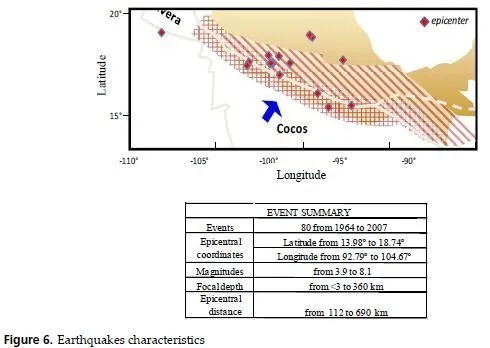Analysis and consequent account of initial accelerograms transformation will become the basis for site effect analysis at strong seismic loadings (fig. 17) (Zaalishvili et al., 2010).
Methods of such modeling are based on accordance of spectral properties of modeled and real earthquake. In a whole modeling accuracy depending on the purposes of total motion usage and what characteristics defining structural system behavior must be reproduced.
Earthquake source that is a region of rupture can be considered as point source only for much larger distances than fault size. At close distances effects of finite fault size become more significant. Those phenomena are mainly connected with finite rupture velocity, which causes energy radiation of different fault parts in different times and seismic waves are interference and causes directivity effects (Beresnev & Atkinson, 1997, 1998).
Lets compare amplitude spectra of obtained design accelerograms with spectrum of real earthquake from considered fault. Data analysis (fig. 18 and fig. 19) shows that spectra of calculated and real earthquakes in a whole are similar in their main parameters.
It must be noted that spectrum of vertical component of real earthquake is closer to design spectra. The last fact is quite obvious and is explained by proximity to earthquake source.
Indeed, close earthquakes in general are characterized by predomination of vertical component. Record of TEA station (located in theater) was selected due to its location on dense gravel and has a minimal distortions caused by soil conditions.

Analysis of spectrum of weak earthquake shows that peaks are observed on 1.3 and 5.6 Hz (Fig. 18). In spectra of synthesize accelerograms mentioned amplitudes are also observed. At the same time medium response on strong earthquake, undoubtedly, differ from weak earthquake response (Fig. 19) (Zaalishvili, 2000).

Usage of maps of detailed seismic zoning in units of accelerations at seismic microzonation
level is possible only for calculation method giving results in units of accelerations. Today traditional instrumental method of seismic microzonation does not allow obtaining intensity increments in accelerations due to traditional orientation on macroseismic intensity indexes.
The exclusion is the case of investigation of strong earthquakes accelerations when instrumental records are obtained (in presence of accelerometer) (Zaalishvili, 2000). At the same time investigations are conducted and the problem supposed to be solved.
On the other hand in recent years a new instrumental-calculation method was developed (Zaalishvili, 2006). New method is based on selection from database (including about 5000 earthquake records) soil conditions which are the most appropriate to real soil conditions of the investigated site. Then the selection of seismic records with certain parameters or their intervals follows (magnitude, epicentral distance, and source depth). Then maximal amplitudes are recalculated for given epicentral distances. Absorption coefficient can be calculated by attenuation model for given region.
Thus, a new complex method of seismic hazard assessment providing probability maps of seismic microzonation, which are the basis of earthquake-proof construction, is introduced.
Undoubtedly such approach significantly increases physical validity of final results.
Considered procedures on the level of possible seismic sources zones exploration, maps of detailed seismic zoning and seismic microzonation may differ from described above. So paleoseismological investigations like «trenching» (Rogozhin, 2007), which allow determining more reasonable the recurrence and other features of seismic events realization are also possible when it is necessary.
Today, we have conditions for detailed seismic zoning maps development like the above mentioned but for all the territory of the Northern Caucasus on basis of the modern achievements of engineering seismology. It will give us a possibility to develop probabilistic maps of seismic microzonation with the help of powerful nonexplosive sources, methods taking into account physical soils nonlinearity (Zaalishvili, 2009).
Thus algorithm of seismic hazard assessment of the territory taking into account multiple factors forming seismic intensity was considered. Forms of typical seismic loadings for firm soils are given, which will be changed from site to site in dependence of differences in ground conditions (engineering-geological, geomorphological and gidrogeological conditions)



